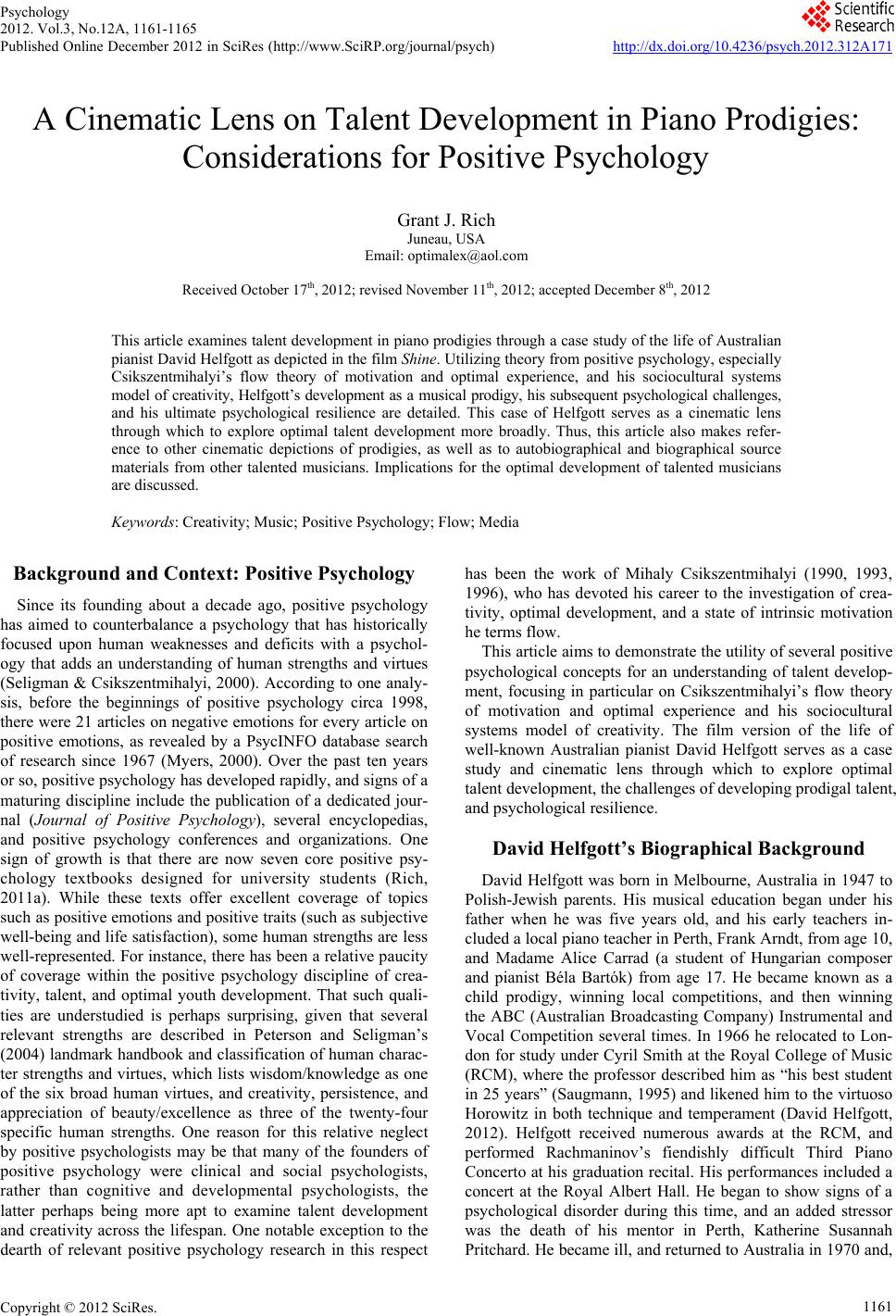 Psychology 2012. Vol.3, No.12A, 1161-1165 Published Online December 2012 in SciRes (http://www.SciRP.org/journal/psych) http://dx.doi.org/10.4236/psych.2012.312A171 Copyright © 2012 SciRes. 1161 A Cinematic Lens on Talent Development in Piano Prodigies: Considerations for Positive Psychology Grant J. Rich Juneau, USA Email: optimalex@aol.com Received October 17th, 2012; revised November 11th, 2012; accepted December 8th, 2012 This article examines talent development in piano prodigies through a case study of the life of Australian pianist David Helfgott as depicted in the film Shine. Utilizing theory from positive psychology, especially Csikszentmihalyi’s flow theory of motivation and optimal experience, and his sociocultural systems model of creativity, Helfgo tt’s development as a musical prodigy, his subsequent psycho logical challenge s, and his ultimate psychological resilience are detailed. This case of Helfgott serves as a cinematic lens through which to explore optimal talent development more broadly. Thus, this article also makes refer- ence to other cinematic depictions of prodigies, as well as to autobiographical and biographical source materials from other talented musicians. Implications for the optimal development of talented musicians are discussed. Keywords: Creativity; Music; Positive Psychology; Flow; Media Background and Context: Positive Psychology Since its founding about a decade ago, positive psychology has aimed to counterbalance a psychology that has historically focused upon human weaknesses and deficits with a psychol- ogy that adds an understanding of human strengths and virtues (Seligman & Csikszentmihalyi, 2000). According to one analy- sis, before the beginnings of positive psychology circa 1998, there were 21 articles on negative emotions for every article on positive emotions, as revealed by a PsycINFO database search of research since 1967 (Myers, 2000). Over the past ten years or so, positive psychology has developed rapidly, and signs of a maturing discipline include the publication of a dedicated jour- nal (Journal of Positive Psychology), several encyclopedias, and positive psychology conferences and organizations. One sign of growth is that there are now seven core positive psy- chology textbooks designed for university students (Rich, 2011a). While these texts offer excellent coverage of topics such as positive emotions and positive traits (such as subjective well-being and life satisfaction), some human strengths are less well-represented. For instance, there has been a relative paucity of coverage within the positive psychology discipline of crea- tivity, talent, and optimal youth development. That such quali- ties are understudied is perhaps surprising, given that several relevant strengths are described in Peterson and Seligman’s (2004) landmark handbook and classification of human charac- ter strengths and virtues, which lists wisdom/knowledge as one of the six broad human virtues, and creativity, persistence, and appreciation of beauty/excellence as three of the twenty-four specific human strengths. One reason for this relative neglect by positive psychologists may be that many of the founders of positive psychology were clinical and social psychologists, rather than cognitive and developmental psychologists, the latter perhaps being more apt to examine talent development and creativity across the lifespan. One notable exception to the dearth of relevant positive psychology research in this respect has been the work of Mihaly Csikszentmihalyi (1990, 1993, 1996), who has devoted his career to the investigation of crea- tivity, optimal development, and a state of intrinsic motivation he terms flow. This article aims to demonstrate the utility of several positive psychological concepts for an understanding of talent develop- ment, focusing in particular on Csikszentmihalyi’s flow theory of motivation and optimal experience and his sociocultural systems model of creativity. The film version of the life of well-known Australian pianist David Helfgott serves as a case study and cinematic lens through which to explore optimal talent development, the challenges of developing prodigal talent, and psychological resilience. David Helfgott’s Biographical Background David Helfgott was born in Melbourne, Australia in 1947 to Polish-Jewish parents. His musical education began under his father when he was five years old, and his early teachers in- cluded a local piano teacher in Perth, Frank Arndt, from age 10, and Madame Alice Carrad (a student of Hungarian composer and pianist Béla Bartók) from age 17. He became known as a child prodigy, winning local competitions, and then winning the ABC (Australian Broadcasting Company) Instrumental and Vocal Competition several times. In 1966 he relocated to Lon- don for study under Cyril Smith at the Royal College of Music (RCM), where the professor described him as “his best student in 25 years” (Saugmann, 1995) and likened him to the virtuoso Horowitz in both technique and temperament (David Helfgott, 2012). Helfgott received numerous awards at the RCM, and performed Rachmaninov’s fiendishly difficult Third Piano Concerto at his graduation recital. His performances included a concert at the Royal Albert Hall. He began to show signs of a psychological disorder during this time, and an added stressor was the death of his mentor in Perth, Katherine Susannah Pritchard. He became ill, and returned to Australia in 1970 and, 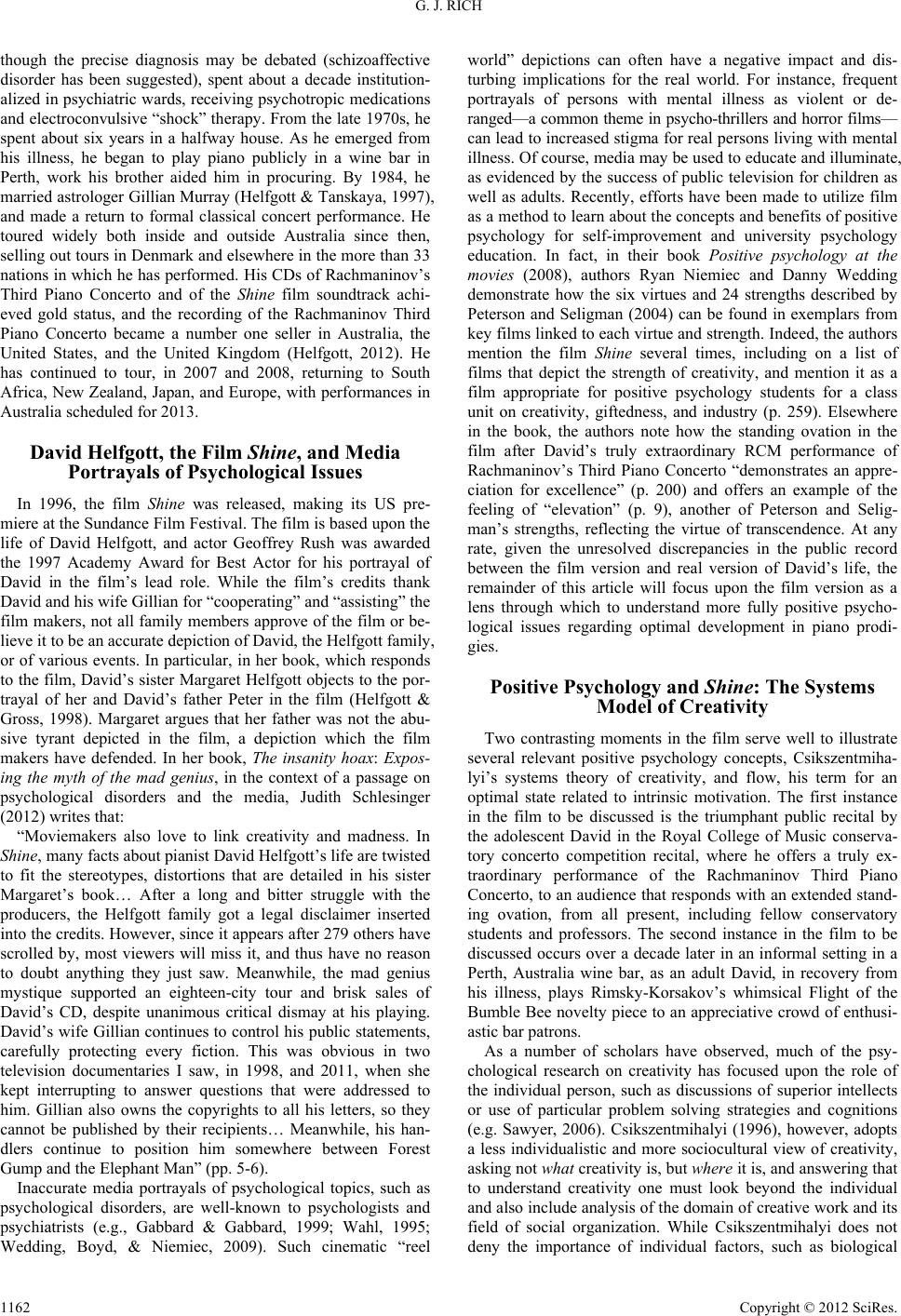 G. J. RICH though the precise diagnosis may be debated (schizoaffective disorder has been suggested), spent about a decade institution- alized in psychiatric wards, receiving psychotropic medications and electroconvulsive “shock” therapy. From the late 1970s, he spent about six years in a halfway house. As he emerged from his illness, he began to play piano publicly in a wine bar in Perth, work his brother aided him in procuring. By 1984, he married astrologer Gillian Murray (Helfgott & Tanskaya, 1997), and made a return to formal classical concert performance. He toured widely both inside and outside Australia since then, selling out tours in Denmark and elsewhere in the more than 33 nations in which he has performed. His CDs of Rachmaninov’s Third Piano Concerto and of the Shine film soundtrack achi- eved gold status, and the recording of the Rachmaninov Third Piano Concerto became a number one seller in Australia, the United States, and the United Kingdom (Helfgott, 2012). He has continued to tour, in 2007 and 2008, returning to South Africa, New Zealand, Japan, and Europe, with performances in Australia scheduled for 2013. David Helfgott, the Film Shine, and Media Portrayals of Psychological Issues In 1996, the film Shine was released, making its US pre- miere at the Sundance Film Festival. The film is based upon the life of David Helfgott, and actor Geoffrey Rush was awarded the 1997 Academy Award for Best Actor for his portrayal of David in the film’s lead role. While the film’s credits thank David and his wife Gillian for “cooperating” and “assisting” the film makers, not all family members approve of the film or be- lieve it to be an accurate depiction of David, the Helfgott family, or of various events. In particular, in her book, which responds to the film, David’s sister Margaret Helfgott objects to the por- trayal of her and David’s father Peter in the film (Helfgott & Gross, 1998). Margaret argues that her father was not the abu- sive tyrant depicted in the film, a depiction which the film makers have defended. In her book, The insanity hoax: Expos- ing the myth of the mad genius, in the context of a passage on psychological disorders and the media, Judith Schlesinger (2012) writes that: “Moviemakers also love to link creativity and madness. In Shine, many facts about pianist David Helfgott’s life are twisted to fit the stereotypes, distortions that are detailed in his sister Margaret’s book… After a long and bitter struggle with the producers, the Helfgott family got a legal disclaimer inserted into the credits. However, since it appears after 279 others have scrolled by, most viewers will miss it, and thus have no reason to doubt anything they just saw. Meanwhile, the mad genius mystique supported an eighteen-city tour and brisk sales of David’s CD, despite unanimous critical dismay at his playing. David’s wife Gillian continues to control his public statements, carefully protecting every fiction. This was obvious in two television documentaries I saw, in 1998, and 2011, when she kept interrupting to answer questions that were addressed to him. Gillian also owns the copyrights to all his letters, so they cannot be published by their recipients… Meanwhile, his han- dlers continue to position him somewhere between Forest Gump and the Elephant Man” (pp. 5-6). Inaccurate media portrayals of psychological topics, such as psychological disorders, are well-known to psychologists and psychiatrists (e.g., Gabbard & Gabbard, 1999; Wahl, 1995; Wedding, Boyd, & Niemiec, 2009). Such cinematic “reel world” depictions can often have a negative impact and dis- turbing implications for the real world. For instance, frequent portrayals of persons with mental illness as violent or de- ranged—a common theme in psycho-thrillers and horror films— can lead to increased stigma for real persons living with mental illness. Of course, media may be used to educate and illuminate, as evidenced by the success of public television for children as well as adults. Recently, efforts have been made to utilize film as a method to learn about the concepts and benefits of positive psychology for self-improvement and university psychology education. In fact, in their book Positive psychology at the movies (2008), authors Ryan Niemiec and Danny Wedding demonstrate how the six virtues and 24 strengths described by Peterson and Seligman (2004) can be found in exemplars from key films linked to each virtue and strength. Indeed, the authors mention the film Shine several times, including on a list of films that depict the strength of creativity, and mention it as a film appropriate for positive psychology students for a class unit on creativity, giftedness, and industry (p. 259). Elsewhere in the book, the authors note how the standing ovation in the film after David’s truly extraordinary RCM performance of Rachmaninov’s Third Piano Concerto “demonstrates an appre- ciation for excellence” (p. 200) and offers an example of the feeling of “elevation” (p. 9), another of Peterson and Selig- man’s strengths, reflecting the virtue of transcendence. At any rate, given the unresolved discrepancies in the public record between the film version and real version of David’s life, the remainder of this article will focus upon the film version as a lens through which to understand more fully positive psycho- logical issues regarding optimal development in piano prodi- gies. Positive Psychology and Shine: The Systems Model of Creativity Two contrasting moments in the film serve well to illustrate several relevant positive psychology concepts, Csikszentmiha- lyi’s systems theory of creativity, and flow, his term for an optimal state related to intrinsic motivation. The first instance in the film to be discussed is the triumphant public recital by the adolescent David in the Royal College of Music conserva- tory concerto competition recital, where he offers a truly ex- traordinary performance of the Rachmaninov Third Piano Concerto, to an audience that responds with an extended stand- ing ovation, from all present, including fellow conservatory students and professors. The second instance in the film to be discussed occurs over a decade later in an informal setting in a Perth, Australia wine bar, as an adult David, in recovery from his illness, plays Rimsky-Korsakov’s whimsical Flight of the Bumble Bee novelty piece to an appreciative crowd of enthusi- astic bar patrons. As a number of scholars have observed, much of the psy- chological research on creativity has focused upon the role of the individual person, such as discussions of superior intellects or use of particular problem solving strategies and cognitions (e.g. Sawyer, 2006). Csikszentmihalyi (1996), however, adopts a less individualistic and more sociocultural view of creativity, asking not what creativity is, but where it is, and answering that to understand creativity one must look beyond the individual and also include analysis of the domain of creative work and its field of social organization. While Csikszentmihalyi does not deny the importance of individual factors, such as biological Copyright © 2012 SciRes. 1162 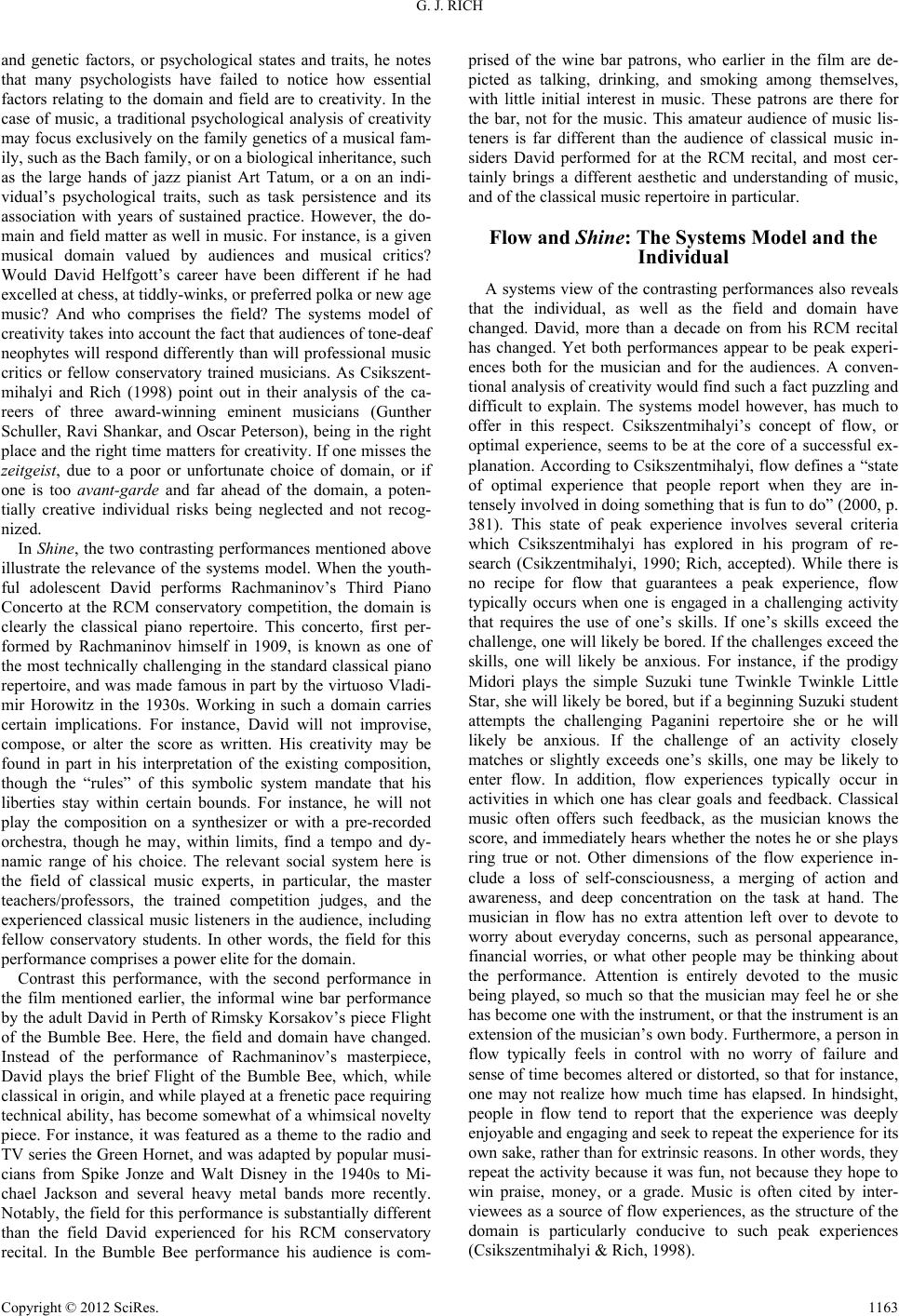 G. J. RICH and genetic factors, or psychological states and traits, he notes that many psychologists have failed to notice how essential factors relating to the domain and field are to creativity. In the case of music, a traditional psychological analysis of creativity may focus exclusively on the family genetics of a musical fam- ily, such as the Bach family, or on a biological inheritance, such as the large hands of jazz pianist Art Tatum, or a on an indi- vidual’s psychological traits, such as task persistence and its association with years of sustained practice. However, the do- main and field matter as well in music. For instance, is a given musical domain valued by audiences and musical critics? Would David Helfgott’s career have been different if he had excelled at chess, at tiddly-winks, or preferred polka or new age music? And who comprises the field? The systems model of creativity takes into account the fact that audiences of tone-deaf neophytes will respond differently than will professional music critics or fellow conservatory trained musicians. As Csikszent- mihalyi and Rich (1998) point out in their analysis of the ca- reers of three award-winning eminent musicians (Gunther Schuller, Ravi Shankar, and Oscar Peterson), being in the right place and the right time matters for creativity. If one misses the zeitgeist, due to a poor or unfortunate choice of domain, or if one is too avant-garde and far ahead of the domain, a poten- tially creative individual risks being neglected and not recog- nized. In Shine, the two contrasting performances mentioned above illustrate the relevance of the systems model. When the youth- ful adolescent David performs Rachmaninov’s Third Piano Concerto at the RCM conservatory competition, the domain is clearly the classical piano repertoire. This concerto, first per- formed by Rachmaninov himself in 1909, is known as one of the most technically challenging in the standard classical piano repertoire, and was made famous in part by the virtuoso Vladi- mir Horowitz in the 1930s. Working in such a domain carries certain implications. For instance, David will not improvise, compose, or alter the score as written. His creativity may be found in part in his interpretation of the existing composition, though the “rules” of this symbolic system mandate that his liberties stay within certain bounds. For instance, he will not play the composition on a synthesizer or with a pre-recorded orchestra, though he may, within limits, find a tempo and dy- namic range of his choice. The relevant social system here is the field of classical music experts, in particular, the master teachers/professors, the trained competition judges, and the experienced classical music listeners in the audience, including fellow conservatory students. In other words, the field for this performance comprises a power elite for the domain. Contrast this performance, with the second performance in the film mentioned earlier, the informal wine bar performance by the adult David in Perth of Rimsky Korsakov’s piece Flight of the Bumble Bee. Here, the field and domain have changed. Instead of the performance of Rachmaninov’s masterpiece, David plays the brief Flight of the Bumble Bee, which, while classical in origin, and while played at a frenetic pace requiring technical ability, has become somewhat of a whimsical novelty piece. For instance, it was featured as a theme to the radio and TV series the Green Hornet, and was adapted by popular musi- cians from Spike Jonze and Walt Disney in the 1940s to Mi- chael Jackson and several heavy metal bands more recently. Notably, the field for this performance is substantially different than the field David experienced for his RCM conservatory recital. In the Bumble Bee performance his audience is com- prised of the wine bar patrons, who earlier in the film are de- picted as talking, drinking, and smoking among themselves, with little initial interest in music. These patrons are there for the bar, not for the music. This amateur audience of music lis- teners is far different than the audience of classical music in- siders David performed for at the RCM recital, and most cer- tainly brings a different aesthetic and understanding of music, and of the classical music repertoire in particular. Flow and Shine: The Systems Model and the Individual A systems view of the contrasting performances also reveals that the individual, as well as the field and domain have changed. David, more than a decade on from his RCM recital has changed. Yet both performances appear to be peak experi- ences both for the musician and for the audiences. A conven- tional analysis of creativity would find such a fact puzzling and difficult to explain. The systems model however, has much to offer in this respect. Csikszentmihalyi’s concept of flow, or optimal experience, seems to be at the core of a successful ex- planation. According to Csikszentmihalyi, flow defines a “state of optimal experience that people report when they are in- tensely involved in doing something that is fun to do” (2000, p. 381). This state of peak experience involves several criteria which Csikszentmihalyi has explored in his program of re- search (Csikzentmihalyi, 1990; Rich, accepted). While there is no recipe for flow that guarantees a peak experience, flow typically occurs when one is engaged in a challenging activity that requires the use of one’s skills. If one’s skills exceed the challenge, one will likely be bored. If the challenges exceed the skills, one will likely be anxious. For instance, if the prodigy Midori plays the simple Suzuki tune Twinkle Twinkle Little Star, she will likely be bored, but if a beginning Suzuki student attempts the challenging Paganini repertoire she or he will likely be anxious. If the challenge of an activity closely matches or slightly exceeds one’s skills, one may be likely to enter flow. In addition, flow experiences typically occur in activities in which one has clear goals and feedback. Classical music often offers such feedback, as the musician knows the score, and immediately hears whether the notes he or she plays ring true or not. Other dimensions of the flow experience in- clude a loss of self-consciousness, a merging of action and awareness, and deep concentration on the task at hand. The musician in flow has no extra attention left over to devote to worry about everyday concerns, such as personal appearance, financial worries, or what other people may be thinking about the performance. Attention is entirely devoted to the music being played, so much so that the musician may feel he or she has become one with the instrument, or that the instrument is an extension of the musician’s own body. Furthermore, a person in flow typically feels in control with no worry of failure and sense of time bec omes altered or distorted, so that for instance, one may not realize how much time has elapsed. In hindsight, people in flow tend to report that the experience was deeply enjoyable and engaging and seek to repeat the experience for its own sake, rather than for extrinsic reasons. In other words, they repeat the activity because it was fun, not because they hope to win praise, money, or a grade. Music is often cited by inter- viewees as a source of flow experiences, as the structure of the domain is particularly conducive to such peak experiences (Csikszentmihalyi & Rich, 1998). Copyright © 2012 SciRes. 1163 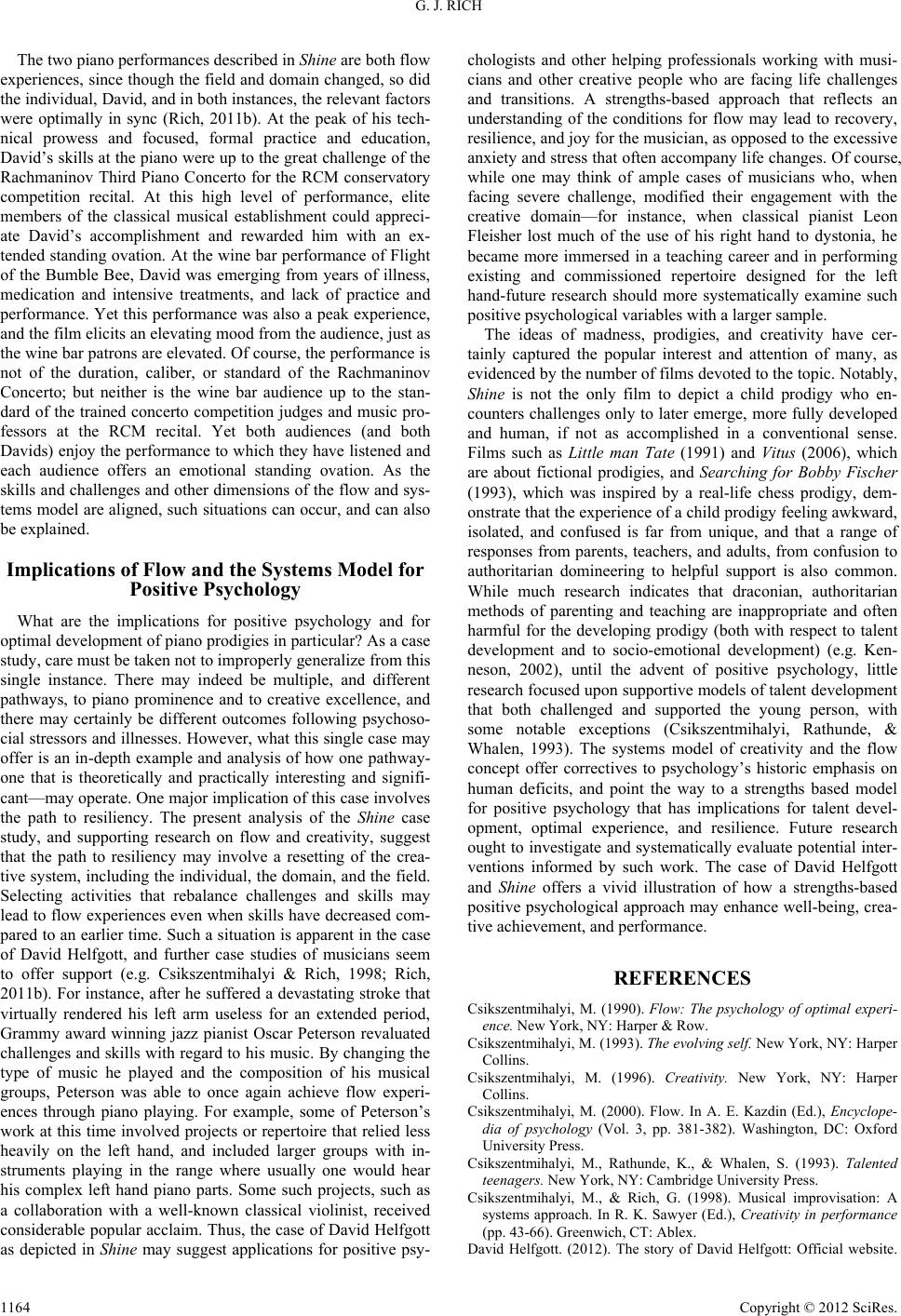 G. J. RICH The tw o pi an o pe r fo r ma n c es d e sc ri b e d in Shine are both flow experiences, since though the field and domain changed, so did the individual, David, and in both instances, the relevant factors were optimally in sync (Rich, 2011b). At the peak of his tech- nical prowess and focused, formal practice and education, David’s skills at the piano were up to the great challenge of the Rachmaninov Third Piano Concerto for the RCM conservatory competition recital. At this high level of performance, elite members of the classical musical establishment could appreci- ate David’s accomplishment and rewarded him with an ex- tended standing ovation. At the wine bar performance of Flight of the Bumble Bee, David was emerging from years of illness, medication and intensive treatments, and lack of practice and performance. Yet this performance was also a peak experience, and the film elicits an elevating mood from the audience, just as the wine bar patrons are elevated. Of course, the performance is not of the duration, caliber, or standard of the Rachmaninov Concerto; but neither is the wine bar audience up to the stan- dard of the trained concerto competition judges and music pro- fessors at the RCM recital. Yet both audiences (and both Davids) enjoy the performance to which they have listened and each audience offers an emotional standing ovation. As the skills and challenges and other dimensions of the flow and sys- tems model are aligned, such situations can occur, and can also be explained. Implications of Flow and the Systems Model for Positive Psychology What are the implications for positive psychology and for optimal development of piano prodigies in particular? As a case study, care must be taken not to improperly generalize from this single instance. There may indeed be multiple, and different pathways, to piano prominence and to creative excellence, and there may certainly be different outcomes following psychoso- cial stressors and illnesses. However, what this single case may offer is an in-depth example and analysis of how one pathway- one that is theoretically and practically interesting and signifi- cant—may operate. One major implication of this case involves the path to resiliency. The present analysis of the Shine case study, and supporting research on flow and creativity, suggest that the path to resiliency may involve a resetting of the crea- tive system, including the individual, the domain, and the field. Selecting activities that rebalance challenges and skills may lead to flow experiences even when skills have decreased com- pared to an earlier time. Such a situation is apparent in the case of David Helfgott, and further case studies of musicians seem to offer support (e.g. Csikszentmihalyi & Rich, 1998; Rich, 2011b). For instance, after he suffered a devastating stroke that virtually rendered his left arm useless for an extended period, Grammy award winning jazz pianist Oscar Peterson revaluated challenges and skills with regard to his music. By changing the type of music he played and the composition of his musical groups, Peterson was able to once again achieve flow experi- ences through piano playing. For example, some of Peterson’s work at this time involved projects or repertoire that relied less heavily on the left hand, and included larger groups with in- struments playing in the range where usually one would hear his complex left hand piano parts. Some such projects, such as a collaboration with a well-known classical violinist, received considerable popular acclaim. Thus, the case of David Helfgott as depicted in Shine may suggest applications for positive psy- chologists and other helping professionals working with musi- cians and other creative people who are facing life challenges and transitions. A strengths-based approach that reflects an understanding of the conditions for flow may lead to recovery, resilience, and joy for the musician, as opposed to the excessive anxiety and stress that often accompany life changes. Of course, while one may think of ample cases of musicians who, when facing severe challenge, modified their engagement with the creative domain—for instance, when classical pianist Leon Fleisher lost much of the use of his right hand to dystonia, he became more immersed in a teaching career and in performing existing and commissioned repertoire designed for the left hand-future research should more systematically examine such positive psychological variables with a larger sample. The ideas of madness, prodigies, and creativity have cer- tainly captured the popular interest and attention of many, as evidenced by the number of films devoted to the topic. Notably, Shine is not the only film to depict a child prodigy who en- counters challenges only to later emerge, more fully developed and human, if not as accomplished in a conventional sense. Films such as Little man Tate (1991) and Vitus (2006), which are about fictional prodigies, and Searching for Bobby Fischer (1993), which was inspired by a real-life chess prodigy, dem- onstrate that the experience of a child prodigy feeling awkward, isolated, and confused is far from unique, and that a range of responses from parents, teachers, and adults, from confusion to authoritarian domineering to helpful support is also common. While much research indicates that draconian, authoritarian methods of parenting and teaching are inappropriate and often harmful for the developing prodigy (both with respect to talent development and to socio-emotional development) (e.g. Ken- neson, 2002), until the advent of positive psychology, little research focused upon supportive models of talent development that both challenged and supported the young person, with some notable exceptions (Csikszentmihalyi, Rathunde, & Whalen, 1993). The systems model of creativity and the flow concept offer correctives to psychology’s historic emphasis on human deficits, and point the way to a strengths based model for positive psychology that has implications for talent devel- opment, optimal experience, and resilience. Future research ought to investigate and systematically evaluate potential inter- ventions informed by such work. The case of David Helfgott and Shine offers a vivid illustration of how a strengths-based positive psychological approach may enhance well-being, crea- tive achievement, and performance. REFERENCES Csikszentmihalyi, M. (1990). Flow: The psychology of optimal experi- ence. New York, NY: Harper & Row. Csikszentmihalyi, M. (1993). The evolving self. New York, NY: Ha rper Collins. Csikszentmihalyi, M. (1996). Creativity. New York, NY: Harper Collins. Csikszentmihalyi, M. (2000). Flow. In A. E. Kazdin (Ed.), Encyclope- dia of psychology (Vol. 3, pp. 381-382). Washington, DC: Oxford University Press. Csikszentmihalyi, M., Rathunde, K., & Whalen, S. (1993). Talented teenagers. New York, NY: Cambridge University Press. Csikszentmihalyi, M., & Rich, G. (1998). Musical improvisation: A systems approach. In R. K. Sawyer (Ed.), Creativity in performance (pp. 43-66). Gr e enwich, CT: Ablex. David Helfgott. (2012). The story of David Helfgott: Official website. Copyright © 2012 SciRes. 1164 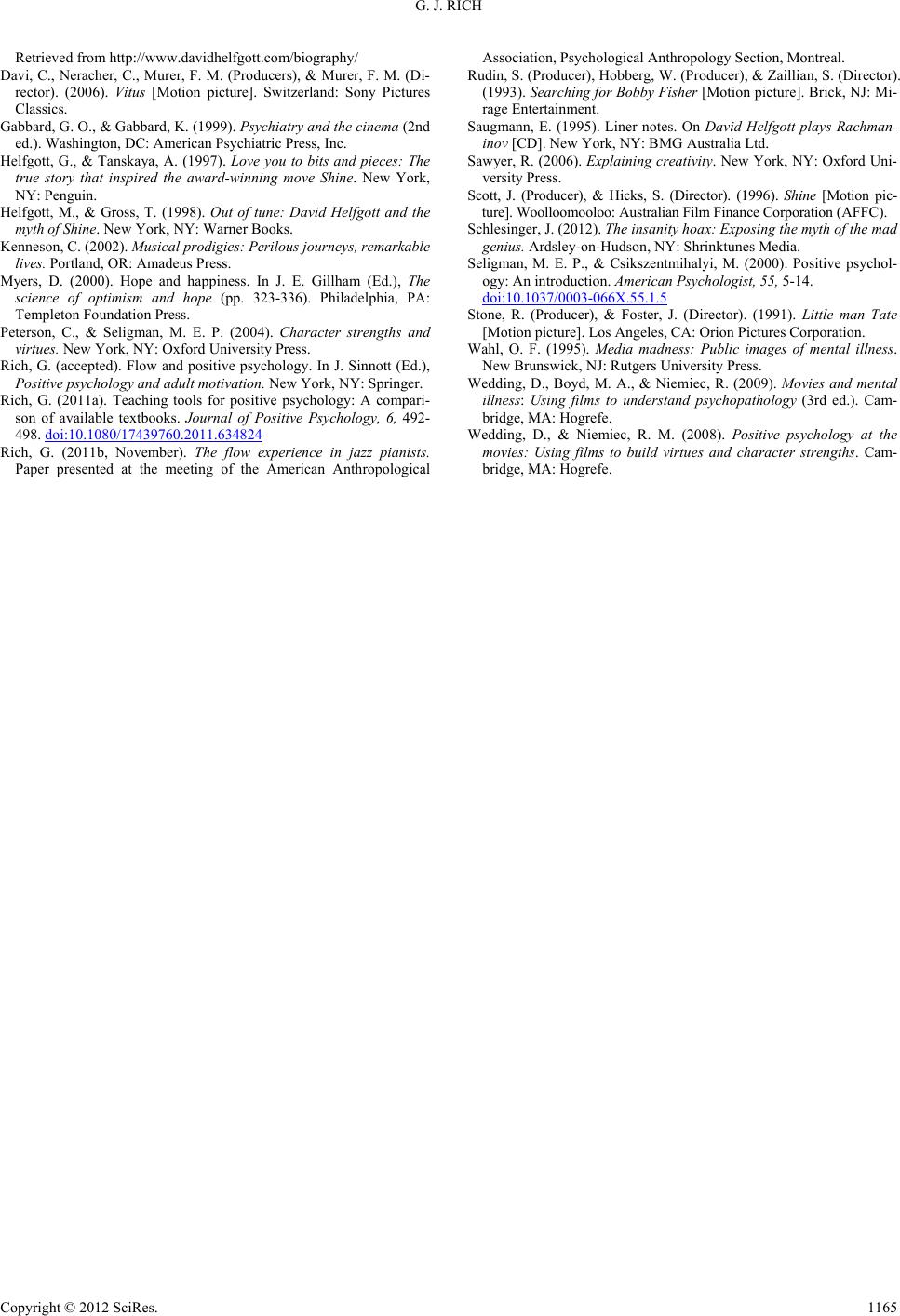 G. J. RICH Copyright © 2012 SciRes. 1165 Retrieved from http://www.davidhelfgott.com/biography/ Davi, C., Neracher, C., Mu rer, F. M. (Producers), & Mu rer, F. M. (Di- rector). (2006). Vitus [Motion picture]. Switzerland: Sony Pictures Classics. Gabbard, G. O., & Gabbard, K. (1999). Psychiatry and the cinema (2nd ed.). Washington, DC: American Psychiatric Press, Inc. Helfgott, G., & Tanskaya, A. (1997). Love you to bits and pieces: The true story that inspired the award-winning move Shine. New York, NY: Penguin. Helfgott, M., & Gross, T. (1998). Out of tune: David Helfgott and the myth of Shine. New York, NY: Warner Book s . Kenneson, C. (2002). Musical pr o di gi es : Perilous journeys, remarkable lives. Portland, OR: Amadeus Press. Myers, D. (2000). Hope and happiness. In J. E. Gillham (Ed.), The science of optimism and hope (pp. 323-336). Philadelphia, PA: Templeton Foundation Pres s. Peterson, C., & Seligman, M. E. P. (2004). Character strengths and virtues. New York, NY: Oxford University Press. Rich, G. (accepted). Flow and positive psychology. In J. Sinnott (Ed.), Positive psychology and ad ul t m o t i v ation. New York, NY: Springer. Rich, G. (2011a). Teaching tools for positive psychology: A compari- son of available textbooks. Journal of Positive Psychology, 6, 492- 498. doi:10.1080/17439760.2011.634824 Rich, G. (2011b, November). The flow experience in jazz pianists. Paper presented at the meeting of the American Anthropological Association, Psychological Anthropology Section, Montreal. Rudin, S. (Producer), Hobberg, W. (Producer), & Zaillia n, S. (Director). (1993). Searching for Bobby Fisher [Motion picture]. Brick, NJ: Mi- rage Entertainment. Saugmann, E. (1995). Liner notes. On David Helfgott plays Rachman- inov [CD]. New York, NY: BMG Australia Ltd. Sawyer, R. (2006). Explaining creativity. New York, NY: Oxford Uni- versity Press. Scott, J. (Producer), & Hicks, S. (Director). (1996). Shine [Motion pic- ture]. Woolloomooloo: Australian Film Finance Corporation (AFFC). Schlesinger, J. (2012). The insanity hoax: Exposing the myth of the mad genius. Ardsley-on-Huds o n, NY: Shrinktunes Media. Seligman, M. E. P., & Csikszentmihalyi, M. (2000). Positive psychol- ogy: An introduction. American Psychologist, 55, 5-14. doi:10.1037/0003-066X.55.1.5 Stone, R. (Producer), & Foster, J. (Director). (1991). Little man Tate [Motion picture]. Los Angeles, CA: Orion Pictures Corporatio n . Wahl, O. F. (1995). Media madness: Public images of mental illness. New Brunswick, NJ: Rutgers University Press. Wedding, D., Boyd, M. A., & Niemiec, R. (2009). Movies and mental illness: Using films to understand psychopathology (3rd ed.). Cam- bridge, MA: Hogrefe. Wedding, D., & Niemiec, R. M. (2008). Positive psychology at the movies: Using films to build virtues and character strengths. Cam- bridge, MA: Hogrefe.
|